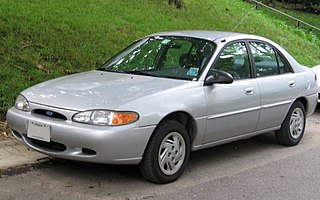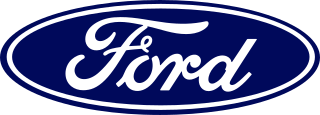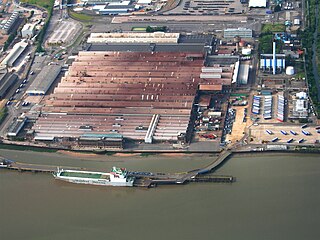
The Ford LT engine (sometimes referred to as the "Dagenham") is a 1.6 litre diesel power inline-four engine used in the Ford Escort as well as its Orion and Escort Van derivatives. It was also installed in the Ford Fiesta Mark 2.

The Ford LT engine (sometimes referred to as the "Dagenham") is a 1.6 litre diesel power inline-four engine used in the Ford Escort as well as its Orion and Escort Van derivatives. It was also installed in the Ford Fiesta Mark 2.
The LT was designed from the beginning exclusively to be a diesel engine, eliminating any compromises required for a design also intended to run on petrol. [1] It was built exclusively at the Ford Dagenham plant. Design work was carried out with the help of German diesel specialists Deutz, who already had a relationship with Ford in providing engines for the heavier-duty Ford Cargos. [1] Output is 40 kW (54 PS; 54 hp) at 4800 rpm. The crankshaft has five bearings and the glowplugs were of the quicker in-cylinder type, reducing pre-heating times to between 7 and 12 seconds depending on the outside temperature. [2]

The Ford Kent is an internal combustion engine from Ford of Europe. Originally developed in 1959 for the Ford Anglia, it is an in-line four-cylinder overhead-valve–type pushrod engine with a cast-iron cylinder head and block.

The Ford Fiesta is a supermini car that was marketed by Ford from 1976 to 2023 over seven generations. Over the years, the Fiesta has mainly been developed and manufactured by Ford's European operations, and had been positioned below the Escort.

The Ford Transit is a family of light commercial vehicles manufactured by the Ford Motor Company since 1965, primarily as a cargo van, but also available in other configurations including a large passenger van, cutaway van chassis, and a pickup truck. The vehicle is also known as the Ford T-Series, a nomenclature shared with Ford's other light commercial vehicles, the Ford F-Series trucks, and the Ford E-Series chassis. As of 2015, 8 million Transit vans have been sold, making it the third best-selling van of all time and has been produced across four basic platform generations, with various "facelift" versions of each.

The Ford CVH engine is a straight-four automobile engine produced by the Ford Motor Company. The engine's name is an acronym for either Compound Valve-angle Hemispherical or Canted Valve Hemispherical, where "Hemispherical" describes the shape of the combustion chamber. The CVH was introduced in 1980 in the third generation European Escort and in 1981 in the first generation North American Escort. Engines for North America were built in Ford's Dearborn Engine plant, while engines for Europe and the UK were built in Ford's then-new Bridgend Engine plant in Wales.

The Ford Bantam is a coupé utility/pickup produced in South Africa. Production of the Bantam spanned three generations, with the vehicle produced in South Africa for sale within the South African market.

Ford Courier is a model nameplate used by Ford since the early 1950s. The Courier moniker has been used on a variety of vehicles all around the world since it was first used in North America for a sedan delivery. The Courier nameplate was also used by Ford for a series of compact pickup trucks and would also see use by Ford of Europe denoting a Fiesta-based panel van. Ford Brazil used the nameplate for a Fiesta-based coupe utility pickup marketed across Latin America.
The Ford Endura-D engine is a 1.8 L (1,753 cc) inline-4 Diesel engine used in a variety of vehicles made by the Ford Motor Company, including the Ford Escort (Europe), Ford Focus, Ford Fiesta, Ford Mondeo, Ford Orion, Ford Sierra, Ford Transit Connect and Ford Ikon.

The Ford Transit Connect is a compact panel van sold by Ford since 2002. Developed by Ford of Europe, the model line replaced sedan-based vans with a dedicated commercial vehicle platform. The model line is the second-smallest vehicle of the Ford Transit range, slotted between the Ford Transit Courier LAV and the Ford Transit Custom LCV/MPV. In line with other Ford Transit variants, passenger-oriented models are marketed as the Ford Tourneo Connect with side windows and rear seats.

The Ford Escort is a small family car that was manufactured by Ford of Europe from 1968 until 2000. In total there were six generations, spread across three basic platforms: the original, rear-wheel-drive Mk.1/Mk.2 (1968–1980), the "Erika" front-wheel-drive Mk.3/Mk.4 (1980–1992), and the final CE-14 Mk.5/Mk.6 (1990–2002) version. Its successor, the Ford Focus, was released in 1998, but the final generation of Escort was phased out gradually, with the panel van version ending production in 2002 in favour of the Ford Transit Connect.

The North American version of the Ford Escort is a range of cars that was sold by Ford from the 1981 to 2003 model years. The direct successor of the Ford Pinto, the Escort also largely overtook the role of the European-imported Ford Fiesta as the smallest vehicle in the Ford model line in North America. Produced across three generations, the first generation was a subcompact; the latter two generations were compact cars. Becoming highly successful in the marketplace, the Escort became the best-selling car in the United States after 1982, a position it would hold for much of the 1980s.

The DLD is the name for an automobile engine family – a group of compact inline-four Diesel engines, involving development by Ford of Britain and/or PSA Group, and also Mazda where it is called the MZ-CD or CiTD. The Ford of Britain/PSA and joint-venture for the production of the DLD/DV was announced in September 1998. Half of the total engine count are produced at Ford of Britain's main plant at Dagenham, England and at Ford's Chennai plant in India, the other half at PSA's Trémery plant in France.

Ford of Europe GmbH is a subsidiary company of Ford Motor Company founded in 1967 in Cork, Ireland, with headquarters in Cologne, Germany.
2002 in motoring deals with developments in the automotive industry that occurred throughout the year 2002 by various automobile manufacturers, grouped by country.

Ford Dagenham is a major automotive factory located in Dagenham, London, operated by the Ford of Britain subsidiary of Ford Motor Company. The plant opened in 1931 and has produced 10,980,368 cars and more than 39,000,000 engines in its history. It covers around 475 acres and has received over £800 million of capital investment since 2000.

The Ford Fiesta Mk1 is the first generation of the Ford Fiesta supermini. Originally introduced in 1976, it was Ford Europe's first multi-national front-wheel-drive automobile, and was available in both 3-door hatchback and panel van derivatives. In 1983, the Fiesta was updated, and the Fiesta Mk2 was introduced.

The Ford Fiesta Mk2 was the second generation of the Ford Fiesta supermini built by Ford Europe. Originally introduced in 1983, it was a mild facelift of the original car, with some re-engineering to accept an expanded range of engines and it was available in 3-door hatchback and panel van styles. It was replaced by the heavily updated Fiesta Mk3 for 1989.

The Ford Fiesta Mk3 was the third generation of the Ford Fiesta supermini built by Ford Europe. Originally introduced in 1989, the Mk3 represented the biggest change to the Fiesta since the original car was introduced in 1976. In addition to the 3-door hatchback and panel van versions that had formed the Fiesta range, a 5-door hatchback was also added. The Fiesta Mk3 was replaced by the Fiesta Mk4 in 1995, but remained on sale until early 1997. The Mk4 was a major restyle of the Mk3, but had the same chassis.

The Fiesta Mark IV was launched in October 1995 and became Britain's best-selling car from 1996 to 1998, when it was overtaken by the all-new Ford Focus, a replacement for the Ford Escort.

Thames was a commercial vehicle brand produced by Ford of Britain.